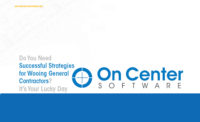For many years, EIFS applicators, general contractors, building owners and EIFS distributors have had difficulty obtaining insurance coverage for EIFS applications. In many situations where EIFS coverage is obtained, it is expensive, rendering EIFS at a competitive disadvantage compared to other exterior wall cladding systems. The question arises: How can applicators, distributors and building/project owners buy coverage for EIFS and EIFS operations which are reasonably priced by insurance carriers?
The insurance industry is slowly responding to this lack of affordable coverage, but the EIFS industry, particularly EIFS applicators, continues to be hard-pressed to find it. Although it is scarce, the good news is that coverage is available. The big problem is the perils covered by the Commercial General Liability policy, which responds to claims for damage caused by alleged faulty EIFS installations. The CGL market for EIFS applications is particularly tough for new and/or claims-ridden clients, and if the coverage for EIFS cannot be obtained, the owner and/or designer may seek an alternative exterior wall cladding in place of EIFS.
Reading the Fine Print
The CGL policy is a standard insurance policy issued to business organizations to protect them against liability claims for bodily injury and property damage arising out of operations. The CGL policy usually covers most perils; however, it does not cover those perils that are specifically listed in the policy. These are known as “exclusions.” The CGL policy as developed by the Insurance Services Office for the insurance industry has an exclusion for EIFS applications.
In addition to being the author of the legal language used in many insurance policies, ISO is also the advisory and rating organization for the property/casualty insurance industry. The ISO CGL policy is used by much of the insurance industry, particularly the big mainline firms like CNA and Travelers, which are also known as ‘admitted’ carriers.
The EIFS exclusion in the CGL policy can be removed upon request. Mainline insurance carriers are reluctant to remove this standard provision, but other insurance carriers, known as ‘surplus lines’, will deviate from the filed rates and provisions of ISO. Some extra premium is usually charged by these insurance carriers to accept this risk.
Insurance for construction is more complicated than personal lines, and the need for EIFS coverage makes it more of a challenge. The real key is not trying to write a project specific policy at the last minute, but to get a good broker to help write a solid application from the outset of the project and to build a relationship with that broker and insurance carrier over time.
Joey Huckaby, an insurance agent in Columbia, S.C., states that there is a difference among agents: some are better equipped to handle the construction industry. According to Huckaby, an agent who is experienced in obtaining construction and EIFS coverage can improve the chances of successfully obtaining it.
In interviewing agents, the EIFS applicator should determine what ‘game plan’ the agent intends to pursue in order to obtain EIFS and other coverages. For example, is it part of the agent’s services contract review to see if there are any provisions in the contract that may be uninsurable? Only an agent familiar with the EIFS and construction industry would know to check for these provisions. Other things to look for in an agent are does the agent know a good broker to take the application to the insurance carrier, and does the agent discuss the project conditions with the broker and the EIFS applicator?
Overcoming Obstacles
The obstacles in obtaining EIFS coverage include: a lack of knowledge by the insurance industry of what EIFS currently are, preconceived impressions of EIFS based on past, decade-old publicity, and an insurance market that is not willing to take on new risks.
Joe Palumbo, assistant vice president and marketing officer for Vela Insurance Services, says, “Insurance underwriters address matters like driving a car through the rear view mirror. They have no way to project what is going to happen in the future except by looking at the past. Too many times, the applicator does not put all the information that the underwriter needs in the application such as past claims against the applicator. The underwriter needs to know what the applicator learned from those claims and what steps the applicator took to correct them.”
The chances of obtaining insurance coverage can be improved if the EIFS applicator takes certain steps like better internal procedures and adoption of specific loss control procedures, continued education about EIFS with the EIFS Doing-it-Right certificates for project leaders, membership in EIMA, and continuing education on general management techniques and wall systems performance, which all contribute to the betterment of the EIFS application firm. The length of time the applicator has been in business is important, too. Demonstration of the EIFS applicator’s strong skills in applying EIFS, their track record of successful performance on previous projects, and the lack of claims against the EIFS applicator will be strong evidence that the exclusion should be dropped.
Crileen Kixmoeller, vice president of underwriting at James River Insurance Company, states, “James River underwrites the EIFS contractor and does not look at the EIFS industry, per se. When looking at new business from EIFS applicators, James River looks at past performance as a key evaluation factor.”
Huckaby adds that in the last 10 years, the insurance industry has gone from requiring minimum premiums of $50,000 to the current $15,000 for CGLs with EIFS coverage, and they are starting to drop even lower. Vela and James River, both operate in the EIFS CGL market as surplus lines carriers. Both Kixmoeller and Palumbo agree that as the surplus line carriers pick up premium dollars in the EIFS arena, more admitted carriers will be attracted to the EIFS industry.
One of the steps that EIMA is working on to correct this issue is to try and get to the right people in ISO to write EIFS as a separate code class. Currently, the industry tends to get lumped and rated with stucco and masonry and get bunched in with those industries’ loss experience.
The key take away here is that EIFS insurance coverage is available, it just takes a little more care to get it right, and it will continue to improve as the EIFS industry takes steps to rectify the current situation. The EIFS applicator, however, should be prepared to demonstrate superior performance and to provide documentation to the insurance carrier.
EIMA held a panel session on insurance coverage for EIFS during its 2016 annual meeting in May. You may view the entire session by visiting eima.com/eifs-insurance.








